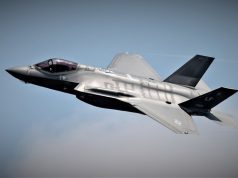US Air Force personnel livestreamed F-35 data directly from the aircraft’s mission systems computers to a connected computer tablet for the first time ever during a ground test last month.
The event at Nellis Air Force Base, Nevada, was a milestone for the Fighter Optimization eXperiment (FoX), a project that seeks to rapidly integrate advanced software and hardware technologies to maximize the F-35’s lethality and survivability.
With the ground test, the Project FoX test team proved they could successfully take data output from a flight test instrumentation system and convert the F-35’s data to communicate with mobile applications running on a commercial tablet. Two apps were tested to demonstrate the idea.
One app, the Battlefield Management Portal, was developed by a team from the 309th Software Maintenance Group (SMXG) out of Hill AFB, Utah, and presents surface-to-air threat information in a new format designed to maximize pilot effectiveness in the suppression of air defenses mission of the F-35. The second app, developed by Lockheed Martin’s Advanced Development Programs branch, introduces the concept of advanced artificial intelligence (AI) to increase the F-35’s advantages against advanced surface-to-air threats.
“In order to stay competitive, we have to innovate,” said Lt. Col. Raven “Rost” LeClair. “It’s as simple as that. We are trying to find ways to go faster for less money, to bring more capability per dollar, and to push more capabilities to the warfighter more quickly.”
LeClair is a test flight commander stationed at Edwards AFB, California, with the 370th Flight Test Squadron (FLTS), a unit assigned to the Air Force Reserve Command’s 413th Flight Test Group. He’s also the F-35 command chief instructor test pilot with the 461st FLTS, an active-duty unit at Edwards, and one of the main players within Project FoX.

Many entities played a part in either managing or assisting the test in some capacity, including a Project FoX government software development team from the 309th SMXG, F-35 maintainers and 59th Test and Evaluation Squadron instrumentation lab specialists out of Nellis, a team from Lockheed Martin and cyber security specialists from the F-35 Joint Program Office (JPO). Lt. Col. Mike Selzter, a leader with Nellis’ Defense Innovation Unit and a co-designer of one of the tested tablet apps, operated the cockpit during the test.
Project FoX was conceived by the 461st FLTS’s Future Technology Team, led by US Marine Corp. F-35 pilot, Maj. Jason “Strap” Schulze. The team was formed with the mission of pursuing advanced aerospace technology and rapid innovation for the F-35, with Project FoX being one of the main vessels in attaining that goal. Together, Schulze and LeClair came up with the concept and roadmap for Project FoX after identifying capability gaps between the vision for agile software development and reality.
Though this initial test was fielded on the F-35, the ambitions for Project FoX reach far beyond just the Lightning II. Its all-encompassing intent is to eventually optimize capabilities for every DoD platform through state-of-the-art methods, combat autonomous toolsets, and hardware and software solutions. Ultimately, the team seeks to transform the combat capability acquisition landscape by making the best tools in the industry and government available to any combat platform through a DoD Combat App Store and cockpit-integrated tablet, LeClair said.
“By opening up the opportunity for innovation, proven in the commercial sector app stores, we can bring the very best combat tools to the warfighter — customized and truly agile combat capability development where fixes can be pushed in days not months,” he said. “It also opens up a whole new world of opportunity for live-fly modeling and simulation. We will be able to find software bugs that escape the lab sooner and fix them faster, rapidly integrate AI tools that could never be run on the actual aircraft due to hardware limitations, provide unprecedented cyber-attack awareness and protection, and crowd source testing on multiple platforms.
“There is no reason why I can’t test the same capability and app on F-18 before F-35 or risk reduce software on F-35 for use by unpiloted aircraft. By connecting a tablet to an aircraft’s data bus, the warfighter and tester will be able to utilize an entire DoD Combat App store of tools, customized to help solve tactical problems in real time.”
The idea of Project FoX traces back to US Navy Vice Adm. Mathias Winter’s vision of the F-35 that he set near the end of the aircraft’s first ten years of flight test. Winter, the then F-35 program executive officer who oversaw the aircraft’s development, imagined the aircraft being able to automatically download updates and new features overnight, similarly to an iPhone or Tesla.
“That is the vision he set out for us, which is a very challenging and inspiring mission, given how complex the aircrafts is,” said Lt. Col. James Valpiani, 461st FLTS commander and F-35 integrated test force director. “It has tens of millions of lines of code. And, of course, it’s different than an iPhone or Tesla in that people are trying to shoot it down. It is a very complex aircraft with a very complex mission and an adversarial mission. To incorporate agile development into that cycle has been the work of the last two years.”
F-35 pilots already fly with tablets in the cockpit, but plugging the tablet into the aircraft is a new idea being pioneered by Edwards, Nellis and Naval Air Weapons Station China Lake in California, he said. Realizing the concerns about safety and security, they started off with just a ground test. The team wanted to prove they could safely connect to the aircraft without interference to the jet’s systems. From a security standpoint, they wanted to prove they didn’t add additional risk.
Also in the works within Project FoX is the FoX BoX. The FoX BoX is slated to contain a cyber-secure chip set designed by a team conducting mission systems testing on the F-18 at NAWS China Lake, just 60 miles north of Edwards. The FoX BoX will run high-level, AI-capable computer processers that will serve as an operating system to communicate to aircraft, allowing the FoX Tablet to function mainly as a visual interface for aircrew.
From here, the team will continue to conduct ground tests to perfect data ingestion on the F-35. They will also soon start testing on the F-18, F-16 and F-22 to prove that Project FoX’s universal concepts are truly compatible with any platform. Eventually, Project FoX capabilities will be tested during flight, hopefully later this year.
“We want to execute in baby steps and a build-up approach,” LeClair said. “As with any new capability, we want to do it safely, securely and effectively.”
Prior to transitioning to the Air Force Reserve in 2018, LeClair held his current F-35 instructor pilot position with the 461st FLTS in an active-duty capacity. He became an Active Guard Reserve (AGR) member and joined the 370th FLTS but remained attached to the 461st as well, maintaining a certain amount of stability within the unit.
“In the active-duty [Air Force], our pilots rotate out on a regular basis every two to three years,” Valpiani said. “It’s difficult to develop real depth of expertise in a platform, especially one as complex as the F-35, in that period. So the challenge that we face is making sure we have a few key cadre in the squadron who can serve as continuity, depth of experience, wisdom — the old hats if you will — who can train new people and give insight to the active-duty force.”



























